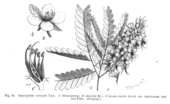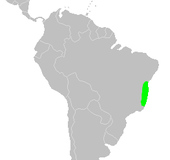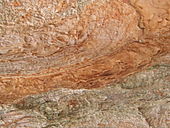Paubrasilia echinata
| Paubrasilia echinata | ||||||||||||
|---|---|---|---|---|---|---|---|---|---|---|---|---|

Paubrasilia echinata |
||||||||||||
| Systematics | ||||||||||||
|
||||||||||||
| Scientific name of the genus | ||||||||||||
| Paubrasilia | ||||||||||||
| Gagnon , HCLima & GPLewis | ||||||||||||
| Scientific name of the species | ||||||||||||
| Paubrasilia echinata | ||||||||||||
| ( Lam. ) Gagnon, HCLima & GPLewis |
Paubrasilia echinata is a species of plant within the legume family (Fabaceae) in the subfamily of the carob family. It is the only species in the genus Paubrasilia .
This endangered species is native to the Brazilian coastal plain . Until the dye could be produced synthetically , it was an important dye plant . The wood of the tree is called brazilwood , Pernambuco - or Pernambuco , designated as rare Bockholz .
description
Appearance and leaf
Paubrasilia echinata grows as a medium-sized, semi- evergreen tree and usually reaches heights of around 12 meters (8 to 30 meters) and trunk diameters of a maximum of 70 centimeters. The trunk is often fluted at the bottom. Its growth rate is low and depends on the growth conditions such as soil type and climate, but it can cope with arid conditions. Its bark and bark are thorny on young specimens , less and less on older ones. The thorns can be up to 2 centimeters long. The bark is covered with lenticels and peeling off in patches and brown. The tree has a reddish exudate .
It thrives in semi-evergreen forests and, depending on where it is located, lets some of its leaves fall during the dry season.
The alternate and spirally arranged, stalked leaves are pinnate alternately in pairs (or incorrectly unpaired to unpaired). There are six to twelve or more Fiedern first order of 12 to 20 pinna leaflet available. The leaflets are sessile, rounded to marginalized and elongated, they are alternating and arranged obliquely forward. The nerve is pinnate with a partly asymmetrical central artery. The petiole and rachis are fine-haired. There are falling stipules.
Inflorescence and flower
The heyday in the state of São Paulo is at the beginning of the rainy season between August and September. The flowering period of a specimen is 10 to 15 days. Usually terminal, rarely axillary on the twigs, many flowers stand together in upright, fine-haired and racemose inflorescences .
The flowers smell slightly sweet like a citrus fruit. The hermaphrodite and stalked flowers are zygomorphic and five-fold with a double flower envelope . The fine-haired flower cup is small and slightly cup-shaped. The five free, fine-haired and elongated sepals are yellowish-green. The five free, obovate petals are intense yellow; the lower petal protrudes and has a dark red sap mark inside , which partly covers almost the entire surface. There are two circles, each with five free stamens, with hairy stamens underneath. The almost sedentary, elongated and hairy-spiny ovary is medium constantly with a slightly hairy pen with a capitate, small and cup-shaped, slightly frayed scar . A flower can be pollinated for less than 24 hours.
Fruit and seeds
The brown, 5 mm long, prickly, woody and flat, tipped legumes are 6 to 8 cm long and 2 to 3 cm wide and are narrow-egg-shaped to oblique crescent-shaped. The legumes ripen from the end of the rainy season to the beginning of the dry season of the following year. When ripe, the legumes open with twisting fruit flaps and release one to three seeds.
The brownish, flat seeds are 1 to 1.5 cm in diameter. The seeds are so hard that it takes two years for them to germinate.
Chromosome number
The number of chromosomes is 2n = 24.
Taxonomy
The first publication of Basionyms Caesalpinia echinata was made in 1785 by Jean Baptiste de Lamarck Monnet in Encyclopédie Méthodique, Botanique 1, 2, S. 461. The re-allocation to the newly established genus Paubrasilia was made in 2016 by Edeline Gagnon, Haroldo Cavalcante de Lima and Gwilym Peter Lewis in PhytoKeys 71: 36. A synonym is Guilandina echinata (Lam.) Spreng. or Caesalpinia obliqua bird .
Occurrence
The natural range of Paubrasilia echinata is between the Brazilian states of Rio Grande do Norte and Rio de Janeiro and in Bahia , Espírito Santo and Pernambuco . Paubrasilia echinata originally thrives mainly in the Mata Atlântica , the coastal forest along the Brazilian Atlantic coast , a semi-evergreen seasonal forest, on soils that have developed from sandy marine deposits.
Hazard and protection
Paubrasilia echinata is classified in the "Red List of Threatened Species" at the IUCN as endangered (" critically endangered"). The threat is caused by the deforestation of the forest areas. The use to extract the dye led to the removal of almost all specimens from the primary forest . The natural sites have been almost completely destroyed. There are small populations in a few locations in the coastal plain .
Paubrasilia echinata was included in CITES Appendix II in September 2007. Paubrasilia echinata has been on the list of threatened plant species in Brazil at the IBAMA ( Brazilian Institute for the Environment and Renewable Natural Resources ) since 1992, where it is listed as "critically endangered". The IPCI ( International Pernambuco Conservation Initiative ) was founded by some wood-importing countries (including Germany) . It also supports the “Pau Brasil Program” of the CEPLAC ( Executive Commission of the Cocoa Planting Plan ). The “Pau Brasil Program” registered 1754 specimens in the natural sites, of which 1669 grew naturally and 85 were planted.
etymology
The resin and bark of Paubrasilia echinata are reddish in color, reminiscent of the embers (Portuguese brasa ) of fire. Hence pau brasil (directly translated "glowing wood") and later as a loan word Brasilholz in German. The name of the country Brazil was derived from pau brasil . Pernambuco is a common name for this species and that of the Brazilian state of Pernambuco .
Other common names are in Portuguese: brasileto , ibirapitanga , orabutá , pau de tinta and pau rosado ; in English: Brazilwood ; in Spanish: palo brasil , leño de brasil .
Other species of the genus of caesalpinia ( Caesalpinia spp.) And the family of legumes (Fabaceae) are called brazilwood.
history
In the first thirty years of Portuguese colonization (1503–1533), Brazilian wood was the only product that was used by both the colonial power and the French from Normandy . The Portuguese Diogo Alvares Correia , whose arrival is dated between 1509 and 1511, was soon known as a middleman for the French. Due to the great economic importance of the resource , the colony was soon called Terra do Brasil , giving the country its current name. The exploitation of this wood led to the destruction of large forest areas on the Atlantic coast of Brazil until 1850 and to the extensive decimation of this species, which is now under nature protection. On December 7, 1978, the pau brasil ( Caesalpinia echinata ) was declared the national tree of Brazil.
use
That the Redwoods belonging (Brazil wood) wood was to obtain a precious red dye ( brasilin used). Redwood has been imported to Europe through Italian traders from India , Sumatra and Ceylon since the 12th century . Fabrics dyed using the finely rasped redwood or its shavings turned bright scarlet or crimson, but the colors often faded quickly to a darker reddish brown. The name "Brasilholz" was transferred to the redwoods discovered around 1500 in Brazil and Jamaica . However, the lack of suitable red dyes meant that Brazil wood was highly valued as a dye until the 17th century. It was also used in the colonial era as construction timber , for turning and for the manufacture of high-quality furniture .
Today, brazil wood is mainly used to make bows for violins and other string instruments, with the heartwood of Paubrasilia echinata being the best. The unprocessed wood for violin bows is included in the CITES regulations.
processing
When processing by sawing, planing or grinding, a pungent odor arises, which leads to irritation of the mucous membranes. Respiratory protection should therefore always be used.
swell
- Elena Mejía, Ximena Buitrón: WG 1 - Trees CASE STUDY 5 - Brazilwood (Caesalpinia echinata) in Brazil. ( conabio.gob.mx PDF).
- Entry in the Flora Brasiliensis .
- E. Gagnon, A. Bruneau, CE Hughes, LP de Queiroz, GP Lewis: A new generic system for the pantropical Caesalpinia group (Leguminosae). In: PhytoKeys. 71, 2016, 1–160, on pp. 36–40, doi: 10.3897 / phytokeys.71.9203 , online (PDF; 44 MB), at ZORA (Zurich Open Repository and Archive), University of Zurich.
Individual evidence
- ↑ Adelung - Grammatical-Critical Dictionary of High German Dialect . P. 1105 f. Munich digitization center, digital library. Accessed July 31, 2020.
- ↑ a b c d e f Elena Mejía, Ximena Buitrón: WG 1 - Trees CASE STUDY 5. - Brazilwood (Caesalpinia echinata) in Brazil ( conabio.gob.mx PDF).
- ^ Entry in the Flora Brasiliensis .
- ↑ Caesalpinia echinata at Tropicos.org. In: IPCN Chromosome Reports . Missouri Botanical Garden, St. Louis.
- ↑ Paubrasilia echinata at KEW Science.
- ↑ Caesalpinia echinata at Tropicos.org. Missouri Botanical Garden, St. Louis.
- ↑ Caesalpinia echinata in the Germplasm Resources Information Network (GRIN), USDA , ARS , National Genetic Resources Program. National Germplasm Resources Laboratory, Beltsville, Maryland.
- ↑ Caesalpinia echinata in the endangered Red List species the IUCN 2010. Posted by: N. Varty, 1998. Accessed August 13, 2011th
- ↑ a b Entry at CITES. ( Page no longer available , search in web archives ) Info: The link was automatically marked as defective. Please check the link according to the instructions and then remove this notice.
- ↑ Thales de Azevedo: Povoamento da Cidade do Salvado. Publicação da Prefeitura Municipal do Salvador Comemorativa do IV Centenario da Cidade, Salvador 1949, pp. 58, 64 f, ISBN 978-85-61458-16-4 .
- ^ Emil [Ernst] Ploß: A book of old colors. Technology of textile colors in the Middle Ages with an outlook on solid colors. Heidelberg and Berlin 1962, reprint Munich 1967, p. 115.
- ^ Amy Butler Greenfield, A Perfect Red - Empire, Espionage and the Qest for the Color of Desire. HarperCollins Publisher, New York 2004, ISBN 0-06-052275-5 , pp. 28 and 29.
Web links
- Datasheet - Pau brasil (Caesalpinia echinata) at arkive.org
- Save the Pernambuco Trees at International Pernambuco Conservation Initiative (IPCI).









